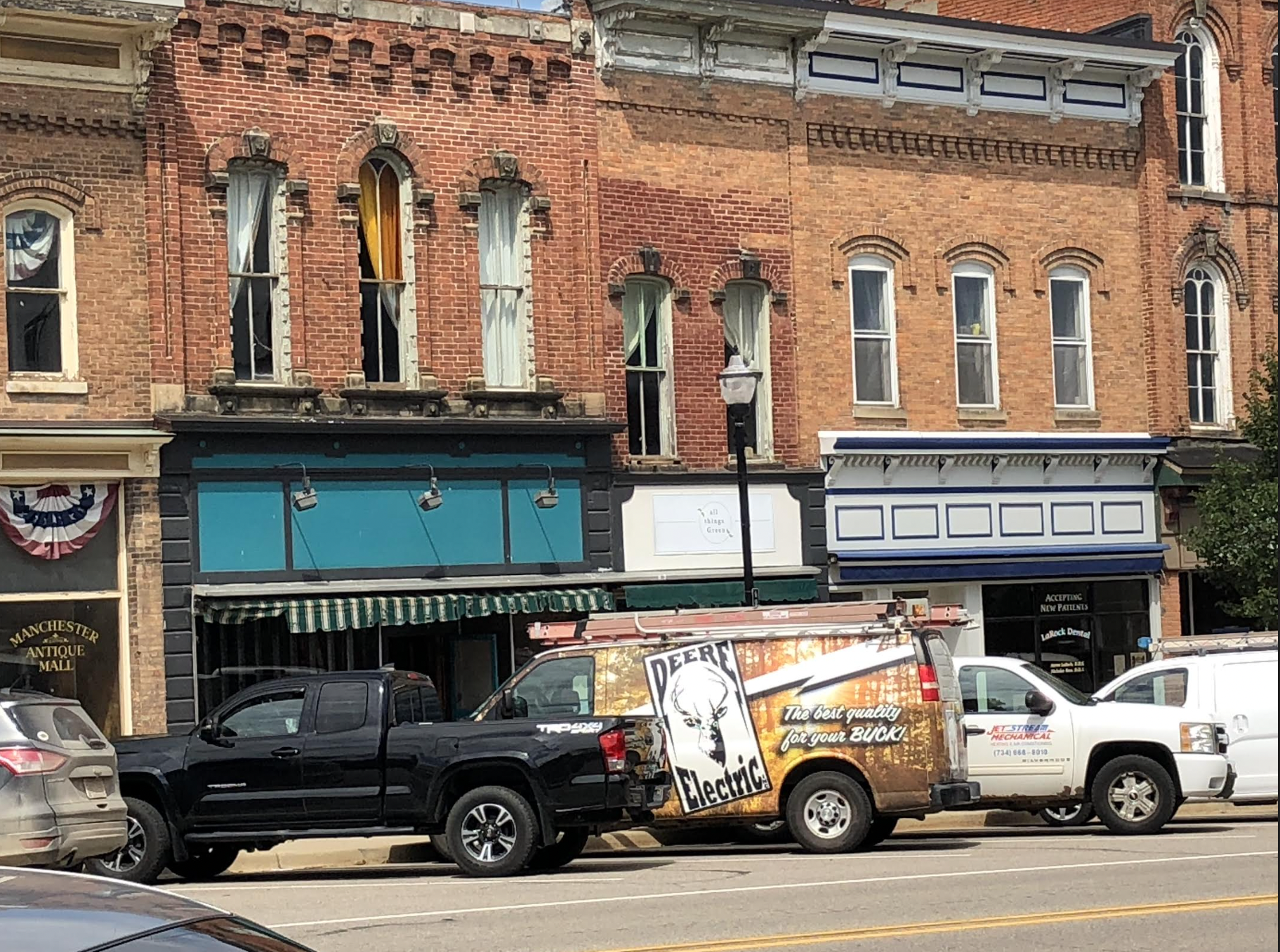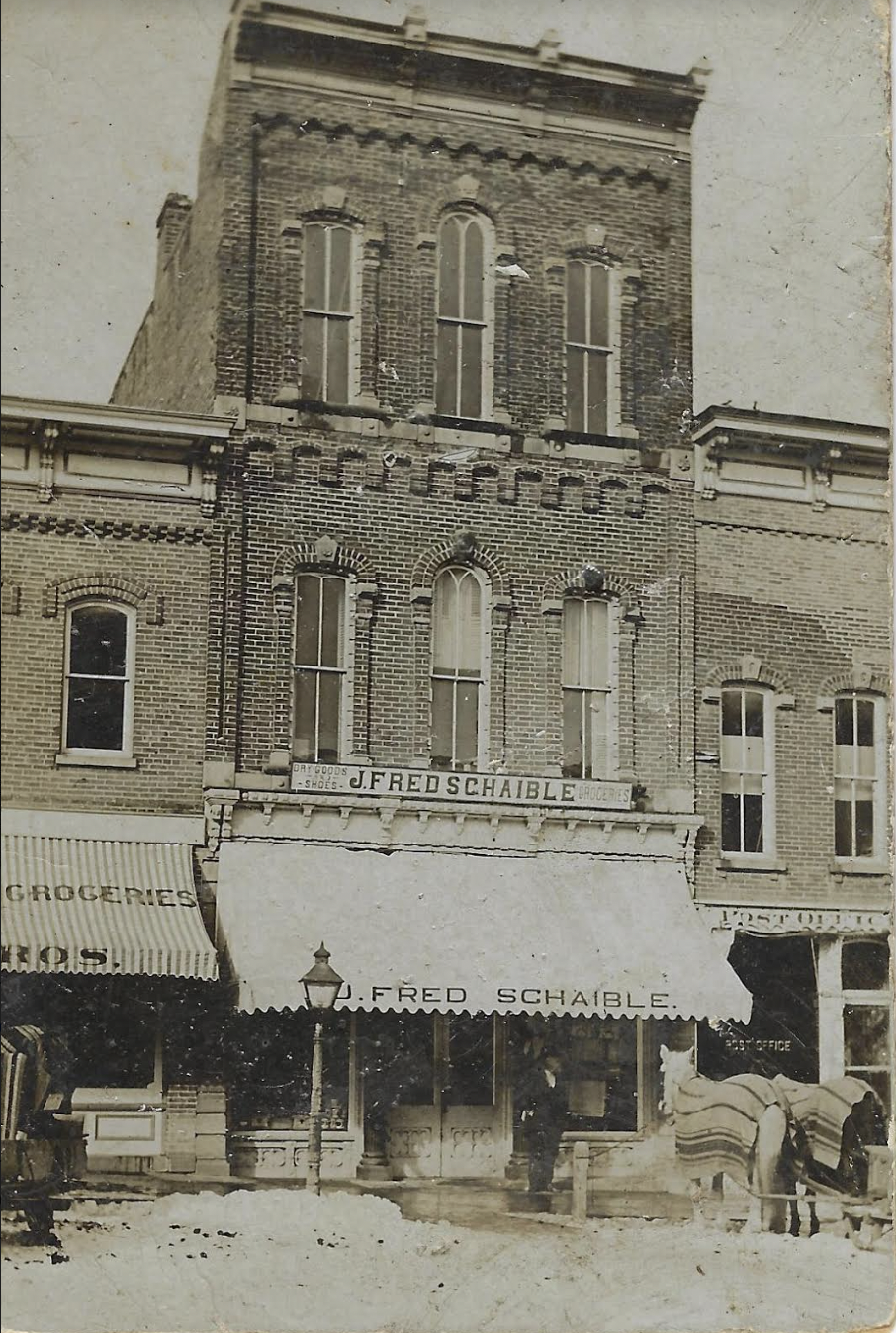The story of a sign in a building

Figure 3: The Joseph Parish advertising sign, painted on what was once the second-floor exterior wall of 126 E Main St, which has been hidden and well-preserved since 122 E Main was built in 1862.
submitted by Ray Berg, Manchester Area Historical Society
Recent visitors to downtown Manchester have noticed ongoing reconstruction at 118 E Main St, traditionally known as “the bakery shop.” Developer Jason Cooper purchased this building, and also the adjacent 122 E Main St building, and is converting them into a combination of office storefront, a planned taqueria/brewery, and apartments/offices. An Edward Jones office (Colleen Newton) has just occupied the front of the 118 building, while All Thingz Green continues to sell products at the 122 building.
Cooper contacted the Manchester Area Historical Society for information on construction dates and historic photographs to help with maintaining and refurbishing a period historic look to the buildings. The 118 E Main building was constructed in 1862 by John Clarkson, originally as a three-story building, with the third floor serving as the meeting place for the Manchester Masons, which was formed in that year. Clarkson operated his mercantile business and apartments on the other two floors.
In 1872, Clarkson then built the 122 E Main building as an “extension” of his 118 E Main site, as reported by Mat Blosser in The Manchester Enterprise. After providing these details and other historic information, Cooper invited the Manchester Area Historical Society to visit the facilities and see the various architectural treatments and 19th-century construction techniques still visible within the buildings.
Figure 2 shows the street view of these buildings, as well as the 126 E Main building adjacent to them (currently the LaRock Dental office). Of particular interest in the interior front of the second floor of 122 E Main is the painting shown in Figure 3.
This painting exists directly on the exposed brick of the west wall of 126 E Main, which also serves as the east interior wall of 122 E Main. The painting, which is an advertisement for a store that existed at one time in the LaRock building, is in extraordinary shape and promotes a wide variety of goods available in the store. Unfortunately, the name of the store owner is partially hidden under the interior ceiling and wall paint and ends in the letters “SH”, which we assume was the name of the owner when painted.
The extraordinary good shape of this painting indicates that it was not exposed to the outside environment for very long before being covered by the construction of the 122 E Main building. You can view a part of the sign through the upper-level window from the sidewalk, especially on a bright, sunny day.
The hunt was on to determine who owned/operated this store!
Background
The MAHS first reviewed the 1856 Manchester Village Plat Map, which is the first map that accurately details all the buildings in the Village of Manchester. This map was produced after the Manchester Mill fire of May 1853, which was caused by the spontaneous combustion of accumulated grain smut. This fire, which occurred on a Sunday morning, combined with unusually strong southeast winds, caused the flames to jump across Main Street, and burned every building on the north side of Main Street between the River Raisin and the old Manchester Hotel.
The 1856 plat map indicates that the only reconstructed building on this part of the north side of Main Street was the current LaRock brick building. The 1856 plat map also contains a partial directory of business and prominent homeowners, who wanted to promote their business or home for a fee. Unfortunately, whoever was occupying 126 E Main in 1856 chose not to be listed in the directory, so our research continued.
The sole building standing at 126 E Main in 1856 would have meant that the west wall of the building would have total visual exposure down the length of Main Street, perfect for painting an outdoor advertisement. This would have remained great exposure until 1862, when Clarkson built his 3-story building, thereby restricting the view of the advertising sign to a much narrower scope (a 15-foot “alley”). And by 1872, with Clarkson building his extension at 122 E Main, the sign then became enclosed in the building. So this advertising sign only served its purpose from approximately 1856–1872, at most, but had restricted viewing after 1862. Thus, we have its good current condition, as it was never painted over and was enclosed within the building.
The Manchester Enterprise did not exist until 1867, so we could not benefit from Mat Blosser’s extraordinarily detailed reporting on commercial activities on Main Street. There are no complete published directories of Manchester for this period. Working with our presumed fact that the last name of the store owner ended in “SH,” and assuming the painting dates from approximately 1856–1862, we began looking for surnames of candidates ending in “SH.” We found prominent Manchester names from this time period such as “English,” “Kish,” “Cash,” etc. We examined various archival records, but none of those prominent names were involved in a downtown Manchester storefront during those years.
We finally found a reference to a Joseph Parish, based on genealogical research on him detailed on Ancestry.com. There was a specific abstract from the 1860 census of the downtown Manchester area, showing Joseph Parish and family aligned with other building owners, businesses, and residential occupants along Main Street, placing him exactly where the 126 E Main building is today relative to other building owners and businesses downtown.
So we have come to the tentative conclusion that the sign painted inside advertised Joseph Parish’s general store. At this point, we are 80% confident of our conclusion, awaiting further archival research.
In reviewing other information on Joseph Parish, we find he was not a long-time operator of the business, having moved to Brooklyn, Michigan, by 1870 and then on to Kent County, Michigan. We hope to learn more about him and will follow up with an updated report.
And, by the way, the genealogical research we examined on Joseph Parish was entered by Chris Parr. Turns out he is a direct relation to our Historical Society early president and motivator and long-time resident, Howard Parr, who himself is a second great-grandson of Joseph Parish!

Figure 2: Current buildings located at 118, 122, and 126 E Main St.

Figure 1: Clarkson 1962 building (originally built as three stories).










You must be logged in to post a comment Login